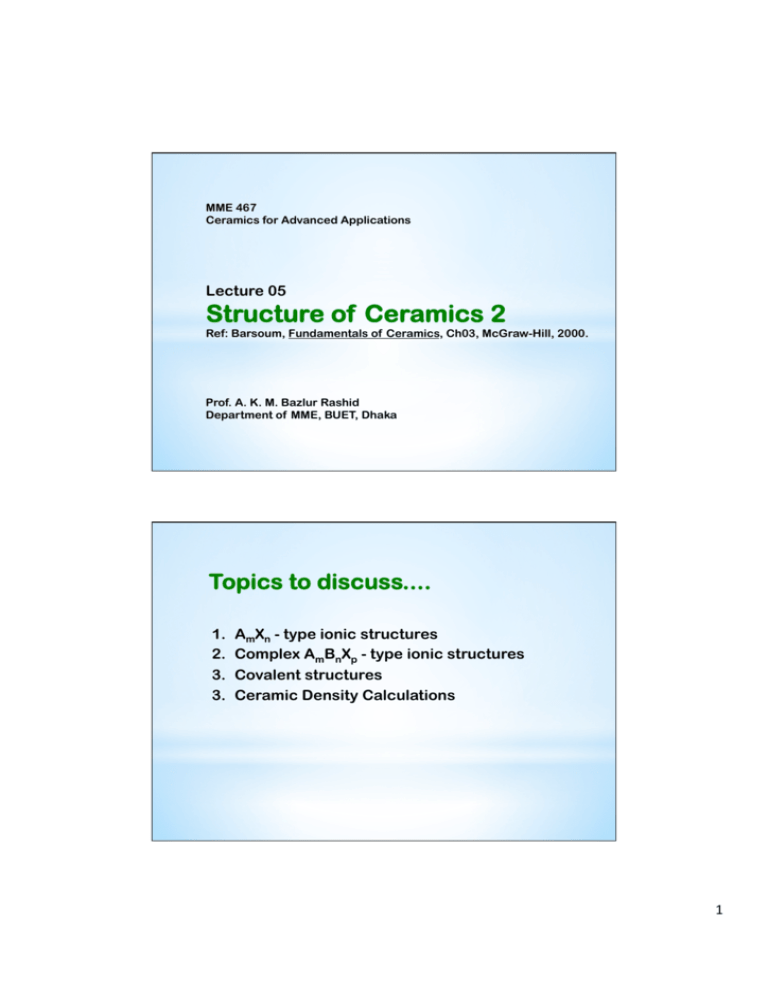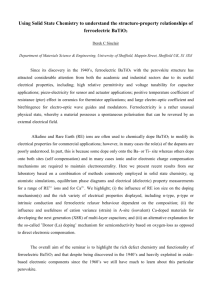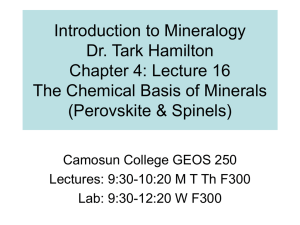Review of ceramic structures 2
advertisement

MME 467 Ceramics for Advanced Applications Lecture 05 Structure of Ceramics 2 Ref: Barsoum, Fundamentals of Ceramics, Ch03, McGraw-Hill, 2000. Prof. A. K. M. Bazlur Rashid Department of MME, BUET, Dhaka Topics to discuss.... 1. 2. 3. 3. AmXn - type ionic structures Complex AmBnXp - type ionic structures Covalent structures Ceramic Density Calculations 1 Corundum Structures q Structure named after compound Al2O3 (alumina and sapphire are the polycrystalline and single crystal forms, respectively). q Based on the 2:3 cation:anion stoichiometry, two-third of the available OH sites are filled by cation. The OH sites form a hexagonal array with the same spacing of the oxygen layer. u Acording to Pauling’s second rule, the bond strength of Al3+ in the OH site is 3/6. Since, oxygen ion has 6 OH sites around it (3 above and 3 below), to satisfy the local neutrality, the Al3+ around oxygen ion must be 4. This is why Al3+ only fill two-third of available octahedral sites. q Examples of corundum structure: Fe2O3 and Cr2O3 . Filling of 2/3 of the octahedral sites in the basal plane of corundum. Only one close- packed anion plane is shown. Plane shown by dashed line in the left figure. Two-third occupancy of the columns of octahedral sites is shown. 2 Ilmenite and Lithium Niobate Structures (Derivatives of corundum structure) In ilmenite (FeTiO3), two-third of octahedral sites are filled with alternating cation layers occupied by Fe and Ti alone. This gives a vertical stacking arrangement, which requires a six cation layer sequence before the structure is repeated. The bond strength of Fe2+ is 2/6 and that of Ti4+ is 4/6, because of oxygen ion having cooridnation with two Fe2+ and two Ti4+. Basal plane of LiNbO3 structure, showing mixed Li, Nb occupancy Ilmenite structure Lithium niobate (LiNbO3 ) is different from Ilmenite in case of cation arrangement. Two-third of occupied octahedral sites are filled with equal number of Li+ and Nb5+. In every pair of adjacent occupied sites, there is one Li+ and one Nb5+. The bond strength of the Li+ and Nb5+ are 1/6 and 5/6, respectively, thus the oxygen ion require to coordinate with two Li+ and two Nb5+. The orientation of the Li-Nb pairs is in the same direction (unlike Fe-Ti in Ilmenite that alternate direction), creating a net dipole for each of the pair, yielding ferroelectric crystal. Cation arrangement in LiNbO3, showing orientation of dipole between Li+ and Nb5+ 3 Perovskite Structure q Many ternary compounds of formula ABO3 (A and B cations differ considerably in size) crystallize in the perovskite (mineral CaTiO3) structure. q An FCC-derivative structure in which the larger A (Ca) cation and oxygen anion together form the FCC lattice. q The smaller B (Ti) cation occupies the octahedral sites and has only oxygen as its nearest neighbours. q The perovskite family includes: 1. titanate compounds (CaTiO3, BaTiO3, SrTiO3 and PbTiO3), 2. zirconate compounds (PbZrO3 and BaZrO3), and 3. other compounds such as LaGaO3 , LaAlO3 and KNbO3 . Many of these compounds crystallize in several polymorphous modifications having slightly distorted perovskite structures. For example, BaTiO3 compound can transform to tetragonal, orthorhombic, or rhombohedral modifications as temperature decreases. ! Perovskite (CaTiO3) structure In each case, the displacive transformation is accomplished by a shift in the titanium atom positions. 4 Structure of Barium Titanate In BaTiO3 unit cell, Ti4+ and Ba2+ are shielded form one another. The bond strength of Ti4+ and Ba2+ are 4/6 and 2/12, respectively, thus oxygen ion need to coordinate with four Ba2+ and two Ti4+. Ion position in high temperature cubic form of BaTiO3. For BaTiO3, the oxygen octahedron coordinating Ti is larger than necessary, being expanded by the large Ba nearest neighbours. This is causing Ti to be unstable and displace from body centered position. Ti atoms can shift in its position relative to O atoms surrounding it, and O atoms can shift relative to Ba atoms at the centre of the cube. The consequence is change of crystal symmetry, yielding noncentrosymmetric crystal and creating net electric dipole along the c-axis. In the room-temperature tetragonal distortion of BaTiO3, it turns out that Ti moves towards an O atom, while the O atoms move in the opposite direction by about the same amount, causing a total displacement of Ti4+ is about 0.15 Å. A more drastic displacement of ions occurs in the tetragonal modification of PbTiO3, where both O and Ti ions are placed in the same direction relative to Pb atoms. The axial ratio c/a is 1.04 in BaTiO3 and 1.06 in PbTiO3, and both crystals contains electric dipoles parallel to [001]. These crystals are, therefore, said to be polarized along the c axis, and possess ferroelectric properties. 5 ! Ion positions on (100) planes for (A) tetragonal BaTiO3 , and (B) PbTiO3. Below room temperature, a further shifting of atoms occurs and dipoles are produced along [110] directions. This produced orthorhombic structure of BiTiO3. Finally at 193 K, another shift occurs so that polarization direction is parallel to [111] direction and a rhombohedral structure results. All of these polymorphs of BiTiO3 possess ferroelectric properties. Typical examples of application: speakers, microphone, sonar transducers, ultrasonic cleaner, actuators for high- precession positioning. 6 Spinel and Inverse Spinel Structures The spinel (MgAl2O4) structure is based on FCC close-packed oxygen sublattice, containing 32 oxygen atoms per unit cell. The metal atoms are distributed among the fraction of 64 available tetrahedral (A+2 atoms) and 32 available octahedral (B+3 atoms) sites. Compounds of stoichiometry AB2O4 in which A and B are divalent and trivalent, respectively, often form as spinel. Compounds of stoichiometry B(AB)O4 in which A and B are both divalent often form as inverse spinel (example Fe(MgFe)O4). Anion form an FCC sublattice, with the unit cell contains 32 oxygen ions, 32 octahedral holes (1/2 filled by B ions) and 64 tetrahedral holes (1/8 filled by A ions). Spinel (MgAl2O3) structure The bond strength is therefore 2/4 for A2+ and 3/6 for B3+. In order to sastify Pauling’s second rule, each oxygen must be coordinated by three A2+ and one B3+. The most commercially important spinel structure ceramics by far are soft magnetic ferrite, which is used as inductors, transformer cores, and read/write heads for magnetic storage media. 7 Covalent Ceramic Structures Si-based: SiO2 , Si3N4 and SiC In all cases building block is SiX4 tetrahedron. SiO4 for all silicates, SiN4 for Si3N4 and SiC4 for SiC. Why? sp3 rules !!! SiX4 SiO2: Every Si bonded to 4 O, every O bonded to 2 Si But SiO4 is still building block. How? Answer: It is all in the sharing. For the most part, SiX4 is corner-shared 8 Diamond Silicon Carbide Cubic unit cell Each atom is at the corner of a tetrahedron, with 4 bonds directed at the corner atoms CN=4 (for close-packing, CN=12), resulting low density Diamond cubic structure, with half C atoms replaced by Si atoms, forming SiC4 tetrahedron at the corner Cubic Silica Diamond cubic structure, with a SiO4 tetrahedron on each Si atom site 9 Ceramic Density Computation ρ= n’ ( ΣAC + ΣAA ) VC NA ρ = theoretical density of ceramic n’ = number of formula unit within the unit cell ΣAC = sum of atomic weights of all cations in the formula unit ΣAA = sum of atomic weights of all anions in the formula unit VC = the unit cell volume NA = Avogrado’s number = 6.023x1023 formula units/mol Example Problem 13.3/Callister/P-391 On the basis of crystal structure, compute the theoretical density of sodium chloride. Atomic radius: rNa = 0.102 nm, rCl = 0.181 nm 2 (rNa+ rCl) n’ = 4 in FCC lattice Σ AC = ANa = 22.99 g/mol Σ AA = ACl = 35.45 g/mol VC = a3 = (2 rNa+ 2 rCl )3 = cm3 rNa ρ = n’ ( ΣAC + ΣAA ) VC NA = 2.14 g/cm3 rCl a 10 Next Class Lecture 06 Effect of Chemical Force on Structure and Physical Properties Ref: Barsoum, Fundamentals of Ceramics, Ch04, McGraw-Hill, 2000. 11







